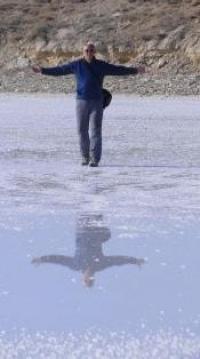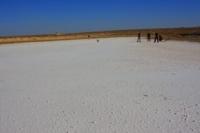Вы здесь
Asmantai-Matai saline march.


Sights of Aktybinsk region.
“The native land, steppe, I have not been given to forget you.
From immense sorrow blazing and bleeding,
My soul suffocates, my heart is burned
And from the bitterness of the heart, boiling blood is hot"
Saken Seyfullin. "Far from the homeland." Omsk 1913 or 1914
Places of interest of the Aktyubinsk region.
Saline land Asmantay-Matai is located in the southern Kazakhstan part of the Ustyurt plateau, is located in the southwestern part of the Aktobe region, not far from the border with the Republic of Uzbekistan. In the south, litter is bordered by the sands of Mataikum, and further south of the sand lies the Atakuduk tract.
In the northeast of the litter lies the Segizkuduk-Blanbai tract, behind which the Kosbulak litter is located. In the northern part of the Asmantai-Matai litter there are many ancient burials - Uzynmola, Bulyukmola, Temirbai, Azgantai and others.
The terrain is sparsely populated. In the south-west of the territory, in the area of Mataikum sands, there are several winterings. Each wintering camp consists of one or two houses with cattle pens attached to them. The houses are adobe, with earthen floors and flat roofs.
During cattle grazing, shepherds live in yurts, in temporary camps near water sources. Traffic on roads is carried out along a poorly developed network of dirt and field roads with a speed of up to 30 km / h in the dry season, and up to 15 km / h on roads laid in sands.
During snowmelt and rains the roads become very wet and become difficult to pass. With heavy traffic, in the dry season, roads crash heavily, a layer of dust forms on them, which, in the absence of wind, rises high into the air.
The territory is a slightly undulating plain that belongs to the Ustyurt plateau. Absolute elevations range from 69 to 137 meters above sea level. The plain is almost flat, with insignificant fluctuations in relative heights with a large number of closed basins occupied by saline march (litter) or takyrs.
The northern slope of the Asmantai-Matai litter and the eastern slope of the Kosbulak litter are very steep (up to 20 °), sometimes turning into ledges up to 25 m high, cut by ravines and dry beds. The most significant dry channels are 3 – 4 m wide, 1.0 – 1.5 m deep.
The depth of the valleys of such channels is 5 – 7 m, and up to 100 m wide. In the southwest of the territory there is an array of fixed tuberous sands (Mataikum sands). The height of the sand hillocks is 4 – 8 m. Driving off-road in the dry season is possible at a speed of up to 20 km / h, in sands and salt marshes it is impossible.
During snowmelt and rains, the soils become very soft and become difficult to pass. Soils are loamy, saline march, sandy, clayey and crushed stone-loamy. Groundwater is mostly salty, occur in sands and near salt marshes at a depth of 2 - 7 meters, in the rest of the territory up to 30 meters.
Hydrography is represented by mine-type wells with a depth of 3 - 7 m, filling up to 200 l / h. In the north of the territory there is an artesian well with a water flow rate of 1800 l / h. In many wells, water is salty or bitter-salty.
Significant areas in the territory are occupied by impassable salt marshes - litter; Asmantai Matai, Kosbulak, Dongeleksor. In March-April, all of them are covered with a layer of fresh water, which evaporates with the onset of heat. The depth of the saline layer is 1.5 - 2.0 m.
During the period of snowmelt and rains, dry channels and ravines are filled with water, which remains in separate depressions until June. The vegetation on the territory is semi-desert and desert. Saksaul is found throughout the territory, which south of the impassable saline march-litter Kosbulak forms continuous thickets on an area of about 4 sq. Km.
In places, a stunted shrub grows (up to 0.4 m) - dzhuzgun, tamarisk. Shrubs (Boyalych, Wormwood, Biyurgun) are ubiquitous. Boyalych in places forms continuous thickets. The sands of Mataikum are fixed by a rare shrub, camel thorn (zhantak) and grassy vegetation.
Grass at the end of June burns out. The climate is sharply continental, desert, arid, with large fluctuations in seasonal and daily air temperatures, with a small (about 110 mm) rainfall per year. Most precipitation falls in spring and autumn.
Winter (mid-November to mid-March) is moderately cold, with little snow. air temperature during the day - 8 - 10 ° С. at night -17 - 25 ° С (minimum - 40 ° С). Persistent frosts begin in early December. Thaws are possible in any month of winter, but there are no positive temperatures at night.
Snow cover is formed in early December, by the end of winter its thickness does not exceed 10 cm. In some winters, snow cover does not form. During the winter up to 20 days with snowstorms. 5 - 7 days with fogs. The soil freezes to a depth of 10 m. Spring (mid-March-May) is characterized by the contrast of day and night air temperatures and a rapid transition from spring to summer.
Snow melts by the end of March, by mid-April, the soil dries. At the beginning of spring, the air temperature during the day is from - 1 ° C to 10 ° C, at night - 7, - 12 ° C, at the end, respectively, during the day 15 - 22 ° C. at night 8 - 12 ° C. In the first half of May night frosts. In March, up to 5 days with fogs.
Precipitation falls in the form of short-term rains. Relative humidity 50-60%. Summer (June-mid-September) is hot and arid. The air temperature during the day is 22 - 32 ° C (maximum 42 ° C), at night 12 - 18 ° C. At the beginning and end of summer nights are cool.
Daytime temperatures usually drop sharply in late August. Precipitation falls in the form of short-term rains. Most precipitation falls at the beginning of the season, least in July. Drought is periodically observed. In summer, there are often dry winds during which the Phenomenon of Mist appears, when visibility decreases to a few hundred meters.
Relative humidity is the lowest in the year at about 30%. Autumn (mid-September to mid-November) in the first half is dry and warm. air temperature during the daytime 10 - 16 ° С, at night 5 - 9 ° С; in the second half, cloudy, rainy. Air temperature during the day 5 - 10 ° С, at night 0 - 10 ° С.
Precipitation falls in the form of drizzling rains; snow falls in mid-November. In the second half of the season up to 5 days with fogs. Winds in the spring and summer are west and southwest, in the fall and winter north and north-east.
The prevailing wind speed is 4-6 m / s. In winter, strong storms are observed, with a speed of up to 15 m / s and more, causing snowstorms and snowstorms that impede the movement of all types of vehicles.
Authority:
Alexander Petrov. The information from a topographical map 1:200 000 scales L- 40 - XXII. Winter home Matai. A.G.Isachenko, A.A.Shlyarnikov. The nature of the world. "Landscapes", Moscow, "Idea", 1989.
Photos
Alexander Petrov.







